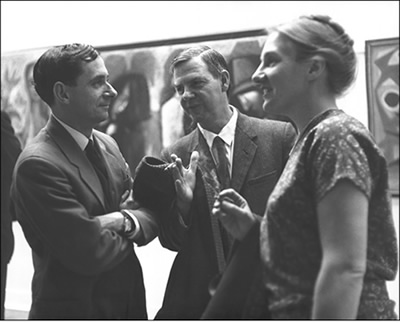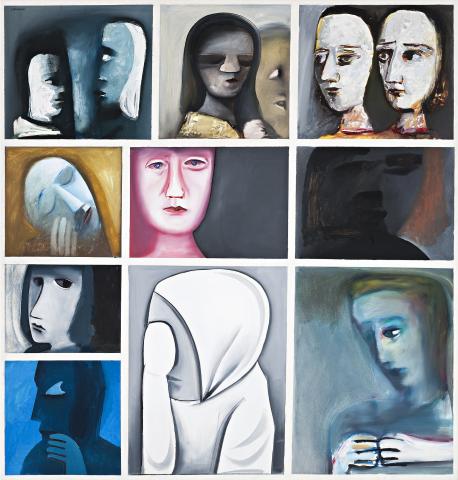DIVIDED PAINTING, c.1962
CHARLES BLACKMAN
oil and enamel paint on composition board
167.5 x 160.0 cm
signed upper left: BLACKMAN
Barbara Blackman, Canberra
Christies, Melbourne, 1 May 2000, lot 179 (as ‘Divided Faces’)
Private collection, Melbourne
Deutscher ~ Menzies, Sydney, 6 December 2006, lot 32A (as ‘Divided Faces’)
Gould collection, Melbourne
Blackman: Paintings, Drawings, The Johnstone Gallery, Brisbane, 2 – 18 April 1963, cat. 66
The Director’s Choice 2012, Gould Galleries, Melbourne, 19 July – 31 August 2012, cat. 8 (illus. in exhibition catalogue)
Figures from a Drama (Dramatis personae), oil on composition board, four paintings, 120.5 x 90.5 cm each, illus. in Moore, F. St. John, Schoolgirls and Angels, National Gallery of Victoria, Melbourne, 1993, p. 84
5. Blackman, Boyd, Whitechapel 1961.jpeg

After a long and productive career, Charles Blackman is now one of the last living members of the generation of Melburnian modern artists known as the Antipodeans, defenders of the merits of figurative art and of a poetic and metaphysical foundation to contemporary painting. During the 1960s, Blackman brought a decade-long formal inquiry to culmination, developing his interest in sequential images into more complex compartmentalised systems he called suites. These new large-scale canvases were met with considerable critical success, winning him the Helena Rubenstein Travelling Art Scholarship in 1960, funding his travel to London where would work alongside fellow Australian émigré artists. United by a sense of national identity, the Australian artists worked to introduce foreign audiences to contemporary Australian art, particularly through key survey exhibitions such as Recent Australian Painting at Whitechapel Gallery in 1961, which featured over fifty Australian artists including Arthur Boyd, Sidney Nolan and Brett Whiteley. Divided Painting, c.1962 was created during Blackman’s sojourn in the English capital and bears the fruit of this stylistic revival in his practice, in particular a marked increase in the scale of his paintings.
Divided Painting, created shortly after Blackman’s celebrated Suites I – VI held in the collections of the state galleries of New South Wales, Queensland and Western Australia, captures the same exploration of sequence, the considered grouping of images in a multi-facetted ensemble, using the connections between each frame to create groups of collective expression and clear vectors through which to read the painted surface. Divided Painting shows a detailed investigation into portraiture, featuring Blackman’s recurrent shadows, silhouettes and faces drawn with an almost naïve simplicity and formal economy of detail. Grouped together, they provide a kaleidoscopic view of individual moments of solitude, grief and confusion – while these figures are physically and formally united in a single work, they remain trapped within their respective frames.
Felicity St John Moore wrote of Blackman’s sequential works in 1993: ‘compared to Blackman’s first experiments with grouping little pictures in a relatively spontaneous manner, these images of the many faces of women, some with shadowy lovers and seen in different lights are at once more ordered and thematic […] with the black borders as hangovers from the comic strip layout of his early newspaper work, in the context of the late 1950s debate, the borders act as a bridge between figuration and abstraction.’1
A humanist, Blackman’s work is often informed by his own experience and his keen observation of people. Divided Painting distils elements of the artist’s investigation of psychological portraiture into small vignettes, frames through which a murky reality is glimpsed. This painting, along with its related work, Dramatis Personae, was inspired by the scenography of theatre productions the artist saw in London. Drawing on this theatrical use of light, and the psychological intensity of the plays of Samuel Beckett that Charles had been reading from Max Nicholson’s library, the figures of Divided Painting are portrayed in distinctly melodramatic poses.2 Perhaps they also express the artist’s experience of his wife’s deteriorating eyesight.
The formal rigidity of this composition, bisected by thick white borders, displays Blackman’s attempt to order his universe. Paradoxically, this same rigid order imposed on his figures effectively separates and isolates them, heightening the chromatic melancholy of the overall composition. As Ray Mathew wrote in a 1966 issue of Art and Australia: ‘Blackman, in an astonishing double, is imposing order, pattern, sanity on his [world], and – at the same time – picturing the threat of order, pattern, sanity’.3
1. Moore, F. St J., Charles Blackman Schoolgirls and Angels, exhibition catalogue, National Gallery of Victoria, Melbourne, 1993, p. 70
2. ibid., p. 84
3. Mathew, R., ‘London’s Blackman’, Art and Australia, Sydney, vol. 3, no. 4, 1966, p. 286
LUCIE REEVES-SMITH
